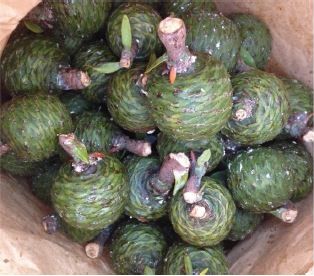PESTS AND DISEASES OF FORESTRY IN NEW ZEALAND
Critical kauri seed collection taking place
Scion is the leading provider of forest-related knowledge in New Zealand
Formerly known as the Forest Research Institute, Scion has been a leader in research relating to forest health for over 50 years. The Rotorua-based Crown Research Institute continues to provide science that will protect all forests from damage caused by insect pests, pathogens and weeds. The information presented below arises from these research activities.
From Forest Health News 288, May 2019.
One of the biggest kauri seed collections to be undertaken in decades has just been completed across the upper North Island in an effort to identify trees that are resistant to kauri dieback.
The seed collection was part of the Scion-led Healthy Trees, Heathy Future (HTHF) programme focused on researching and combating several Phytophthora species, including Phytophthora agathidicida aka kauri dieback.
The coordinated collection saw 14 mana whenua groups working with researchers from Scion, Manaaki Whenua Landcare Research and professional tree climbers from BioSense to collect seed from kauri from northern Northland to Tauranga in the eastern Bay of Plenty.
Mana whenua groups involved include Omahuta, Ngamanawa Inc, Te Roroa, Te Rarawa, Patuharakeke, Tau Iho I Te Po, Te Rawhiti, Ngati Huarere Ki Whangapoua, Te Uri o Hikihiki, Ngati Hine, Ngati Rehia, Te Uri O Hau, Kawerau a Maki and others.
 Kauri seed is enclosed in cones that mature between February and April. Maturation is earliest in Northland and then moves south.
Kauri seed is enclosed in cones that mature between February and April. Maturation is earliest in Northland and then moves south.
Tree climbers used special gear to climb into the tree canopy to harvest cones. It was vital that the cones were collected while still on the tree, so collectors could record which tree they came from, and collectors can go back to gather more if the specimen is identified as being resistant. Cones were then sent to Scion in Rotorua where some of the seed will be raised in a specially commissioned kauri polyhouse within the Scion nursery where strict hygiene precautions ensure it stays free of kauri dieback. Seed not used this year will be placed into a seed bank for mana whenua to use in research or restoration.
This was the fourth year of seed collections in the HTHF programme and was the biggest collection undertaken so far. The 2018 harvest focussed on collection from healthy trees in areas where dieback is known to be present. This year, the aim was to collect from 500+ trees across kauri lands to establish a resource for future research, screening and propagation programmes. Programme leader Dr Nari Williams explains, “By taking seed from mature trees, we’re hoping to get a better understanding of the range of genetic resistance present. This is one part of understanding why and how some trees succumb to dieback and othersremain apparently disease-free.”
When the seedlings are 15 months of age, they are sent to Manaaki Whenua Landcare Research in Auckland where they are screened for resistance to kauri dieback. The plants are flooded with water containing Phytophthora agathidicida to encourage infection. Researchers monitor them closely to see how the disease takes hold and how long they survive after infection. The plants are also analysed to see what chemical reactions are triggered, hoping to find one that may be effective at neutralising the disease.
“Although early days, it’s starting to get really exciting. The team at Manaaki Whenua Landcare Research led by Dr Stan Bellgard and Dr Chantal Probst have started to see a range of responses to how the plants succumb to infection. There is a big difference between understanding what happens in the glasshouse and how vulnerable trees are within the forest, but it gives us hope for the future of kauri,” says Dr Williams.
The team from BioSense, led by Fredrik Hjelm, coordinated the collection teams, mana whenua engagement, cultural, safety and hygiene protocols, and the shipping of the cones. They ensured that groups collecting the cones used strict protocols to ensure no soil, water or organic matter was transferred between sites.
Funding for the kauri stream of the HTHF programme is provided by the Ministry for Business, Innovation and Employment and the Kauri Dieback Programme. Collaborators include Massey University, Manaaki Whenua, Plant and Food Research and Auckland University of Technology. The programme wraps up in September 2019 after six successful years, but the researchers hope to continue the work in partnership with mana whenua.
This information is intended for general interest only. It is not intended to be a substitute for specific specialist advice on any matter and should not be relied on for that purpose. Scion will not be liable for any direct, indirect, incidental, special, consequential or exemplary damages, loss of profits, or any other intangible losses that result from using the information provided on this site.
(Scion is the trading name of the New Zealand Forest Research Institute Limited.)

 Farm Forestry New Zealand
Farm Forestry New Zealand

